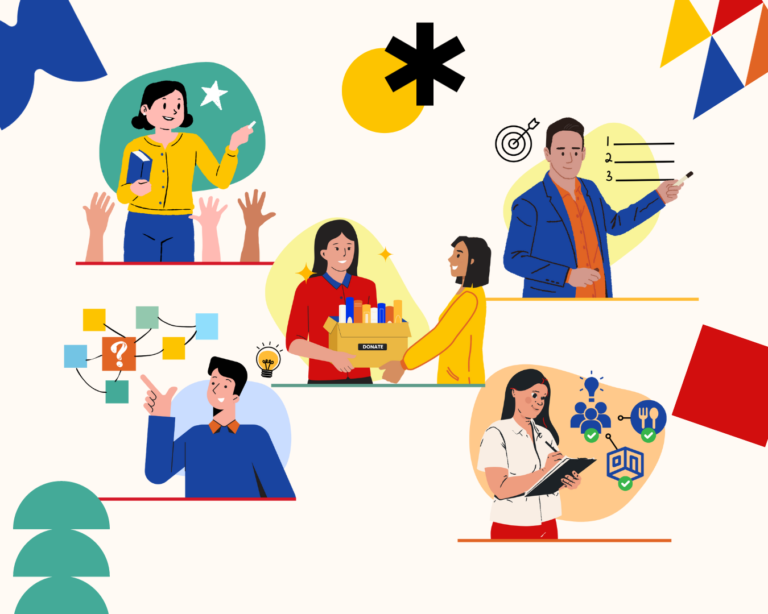Designing learning experiences for our neighbors
Last July, the team hopped back to one of our favorite stomping grounds and Gerson’s alma mater, Philippine Science High School, to co-facilitate the ASEAN Cyberkids Camp 2017. We showed our version of Philippine hospitality to fellow ASEAN nations in the best way we know how: by designing memorable learning experiences for them. Primary school aged students accompanied by tutors came together from the different member states to showcase their creativity through technology and design thinking. The highlight of the camp was a programming competition where all participants were tasked to code using Scratch and exhibit their outputs through multimedia presentations. Our team was responsible for the second portion, in which we conducted two sessions to ensure that their presentations were well-designed and reflective of their capabilities. Working with the ebullient children, whose ideas were as colorful as the diverse national clothing they respectively wore that day, was definitely a breath of fresh air. Now we can proudly say that Habi had a hand in strengthening our country’s ties with our ASEAN neighbors.
Flow
We were given the whole afternoon to conduct the sessions so we decided that it would be best to introduce the basics of design before teaching project pitching skills. This flow allowed the participants to zone in on the aesthetics and content of their presentation first before thinking about how to deliver them.
As a bonus session in the morning, we also conducted a design thinking rush session with the tutors, who had their hands free since their students were busy learning about Scratch during that time. A great way to pass the morning!
This is how our day looked like:
| Time | Activity | Participants |
| 10:30a- 12:30p
AV Room |
Design Thinking Session for Tutors
|
10 tutors |
| 1:30- 3:00p
Samsung Room |
Session 2: Basic Principles of Design for Students
|
20 students |
| 3:30- 5:00p
Samsung Room |
Session 3: How to Pitch a Project
|
20 students |
Insights
Time = friend or nemesis? We tried to work around time limitations as we were only given an hour and 30 minutes for every session. For the first session, we dedicated one activity to help drill each principle. As for the second one, we lessened the time for idea generation so we could focus on pitching itself. While we were tempted to further develop their exciting ideas (ex. robot bodyguards to help students with Wi-Fi needs, school schedule adjustments to help students relax), it was better to spend the time prototyping the presentation format, which was the session’s main learning objective.
Assigned mentorship: Each country pair was escorted by a Senior High School student from PSHS all throughout the event and this helped us facilitate our sessions more smoothly. These 16 and 17 year olds, who acted as Ates and Kuyas, helped with lessening initial apprehensions from the participants and translating the content to their local languages. For instance, we encountered difficulties in translating the technical terms we introduced in the first session (contrast, repetition, alignment and proximity). We had to work with the Ates and Kuyas (and of course the ever reliable Google Translate) to break down the definitions.
Language barriers: In relation to the previous point, we are pushed to simplify our content further to adjust to the different nationalities. Although we’ve conducted several workshops with international audiences, we’re more used to handling Filipinos, who can easily grasp the English language. The language barrier played a huge influence on the workshop design, and we spent a lot of time deciding how to strip the activities down to their most essential components. For example, we couldn’t use the term “memory enhancer” as freely as we typically do in previous workshops; either we replace the phrase completely or define it in a more comprehensive way.
Problem > Tension > Solution worked: The participants were able to latch on to the simplicity of the pitch format. This was evident through the presentations of the four groups where they showcased their ideas on how to make school more fun for students. We taught it this way hoping that they would remember to apply a similar format onto their final presentation for the overall competition.
Habi fine-tuning on the fly: We do our best to acknowledge when particular activities aren’t going as well as we planned them to be. For instance, when we realized that we didn’t need an icebreaker for the 2nd session because of the participants’ high energy levels, we decided to skip Random Lines and go straight to the hands-on activities. We also made mental notes to improve Use Cases, which we introduced in the 3rd session as an introductory activity for project pitching. It didn’t turn out well since the activity was originally designed for adults, and we failed to adjust according to the age of the audience. A good thing about these design thinking activities is that they are easy to unpack, should facilitators need to tweak details like we did.


